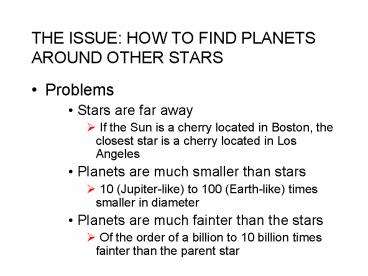THE ISSUE: HOW TO FIND PLANETS AROUND OTHER STARS - PowerPoint PPT Presentation
1 / 10
Title:
THE ISSUE: HOW TO FIND PLANETS AROUND OTHER STARS
Description:
10 (Jupiter-like) to 100 (Earth-like) times smaller in diameter ... The presence of a planet can be inferred by observing a star and analyzing the ... – PowerPoint PPT presentation
Number of Views:23
Avg rating:3.0/5.0
Title: THE ISSUE: HOW TO FIND PLANETS AROUND OTHER STARS
1
THE ISSUE HOW TO FIND PLANETS AROUND OTHER STARS
- Problems
- Stars are far away
- If the Sun is a cherry located in Boston, the
closest star is a cherry located in Los Angeles - Planets are much smaller than stars
- 10 (Jupiter-like) to 100 (Earth-like) times
smaller in diameter - Planets are much fainter than the stars
- Of the order of a billion to 10 billion times
fainter than the parent star
2
THE ISSUE HOW TO FIND PLANETS AROUND OTHER STARS
- Advantages
- Stars are very bright and can be detected at very
large distances - Motion and appearance of stars are affected by
the planets that orbit around them - The presence of a planet can be inferred by
observing a star and analyzing the light that we
receive from it
3
THE MOTION OF THE STAR IS AFFECTED BY THE PLANET
THAT ORBITS AROUND IT
- The planet is orbiting the star because the star
exerts a gravitational force on the planet - The star moves around in a circle because the
planet exerts a gravitational force on the star - Planet and star actually move around a common
center of mass - Mstar Dstar mplanet dplanet
4
Star velocity
Radial velocity
Tangential velocity
The observer can see only the radial velocity
Velocity in the direction to the observer is
negative (-)
Velocity in the direction away from the observer
is positive ()
Observer
5
Max negative radial velocity
6
Zero radial velocity
7
Max positive radial velocity
8
Zero radial velocity
9
WE MEASURE THE VELOCITY OF THE STAR BY ANALYZING
THE LIGHT EMITTED BY THE STAR
10
WE MEASURE THE VELOCITY OF THE STAR BY ANALYZING
THE LIGHT EMITTED BY THE STAR
The shift in position of the line Velocity of
the star ----------------------------------------
------------------------- Position at
rest Speed of light































